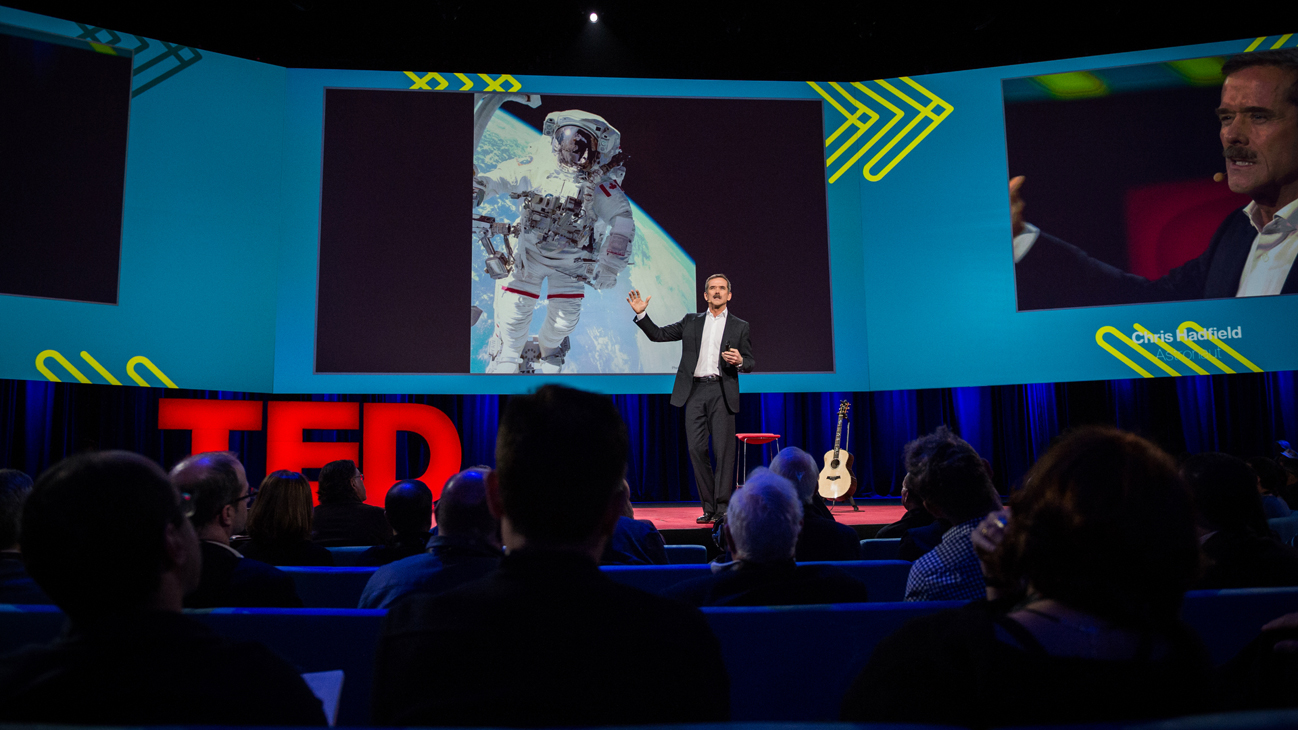On the opening night of TED 2014 in Vancouver, Canadian astronaut Chris Hadfield thrilled TED conference watchers with his out-of-this-world experiences–blasting off into space, going nearly “blind” on a space walk, and landing five months later on Earth in a tiny capsule with Russian comrades. Experiences, he said Monday night, that can teach anyone to conquer fears and achieve planet-sized goals. Here’s an edited portion of his TED Talk [which concluded, not surprisingly, with a rousing standing ovation]:
“I know what the most dangerous thing is I’ve ever done, because NASA does the math… [The] odds of a catastrophic event during the first five shuttle launches was one in nine.”
“So it’s a really interesting day when you wake up at the Kennedy Space Centre, and you’re going to go to space that day. Because you realize that by the end of the day, you’re either going to be floating effortlessly and gloriously in space — or you’ll be dead.”
“As you come around the corner at the Kennedy Space Center, and it’s normally pre-dawn, and in the distance, lit up the huge xenon lights is your space ship – the vehicle that is going to take you off the planet. And the crew is sitting in the Astrovan, sort of hushed, almost holding hands, looking at that as it gets bigger and bigger.”
“We ride the elevator up, and we crawl in on hands and knees into the spaceship…. and sort of worm yourself in and plunk yourself down on your back. And suddenly, what has been a lifetime of dreams and denial is becoming real.”
Take off
“As the time gets closer and closer, this excitement is building, and about three-and-a-half minutes before launch… it sways the whole vehicle, the vehicle is alive underneath you, like an elephant getting up off its knees…”
“Then about 30 seconds before launch, the vehicle is completely alive.”
Then comes the countdown: 3,2,1, lift off.
“It is incredibly powerful to be on board one of these things,” he said.
“You are in the grip of something that is vastly more powerful than you. It’s shaking you… so hard you can’t focus on the instruments in front of you. It’s like you’re in the jaws of some enormous dog.”
“You’re in a very complex place — paying attention, watching the vehicle go through each of its wickets, with a steadily increasing smile on your face.”
“Until finally, after eight minutes and 40 seconds or so, we are finally at exactly the right altitude, exactly the right speed, the right direction, the engine’s shut off, and we’re weightless. And we’re alive.”
Fighting Fears
“Why would we take that risk? Why would you do something that dangerous?”
“In my case, the answer was fairly straight forward. I was inspired as a [9-year-old] youngster that this was what I wanted to do. I watched the first people walk on the Moon, and to me it was an obvious thing, I want to somehow turn myself into that. But the real question is, how do you deal with the danger of it? And the fear that comes from it? How do you deal with fear versus danger?”
He said, he set his goal, and directed himself to all the “small details” that allowed him to be the became the first Canadian Commander of the International Space Station — a million-pound creation that spins around the planet 16 times per day, at eight kilometres per second.
The station’s purpose is to conduct experiments, but is also to allow “us to see the world in a way that is impossible through any other means.”
He described the “jaw dropping gorgeousness” of the turning Earth as a “self propelled art gallery.”
Scary space walk
“The most magnificent part of all that is to go outside on a space walk.”
“You are going through space with the world. It’s an entirely new perspective. You are not looking up at the universe – you and the earth are going through the universe together, and you’re holding on with one hand.”
He also talked about the experience of ‘going blind’ in one eye during the crucial moment.
“I was outside on my first walk when my left eye went blind. And I didn’t know why — suddenly my left eye slammed shut and… I couldn’t figure out my eye wasn’t working.”
He kept working, but without gravity, “tears don’t fall, so you just get a bigger and bigger ball.” Eventually the growing ball of tears broke, and impaired his other eye.
“I was completely blind outside the space ship.”
“So what’s the scariest thing you’ve ever done?” he asked, to howls of laughter at TED 2014.
After years of practicing scenarios of “things go wrong” on Earth — using underwater training labs for example — he and his Houston crew knew what to do. He felt his way back to the space station with the help of ground control, and got inside.
It turned out he wasn’t blind.
“It was just the anti-fog. A mixture of oil and soap that got in my eye,” he said, to laughter from the crowd.
“But the key to that is, by looking at the difference between perceived danger and actual danger — where is the real risk? Where is the real danger? … You can fundamentally change your reaction to things. It allows you to go places, and see things, and do things, that would otherwise be denied to you.”
He challenged people in the crowd to reprogram themselves, to change their primal fears, so that they could achieve their earthly or celestial dreams too.
For the rest of Hadfield’s TED Talk, you’ll have to wait until it’s available online for free at Ted.com later this year, said organizers.
But before he left the stage, he gave a famous rendition of David Bowie’s “Space Oddity” — a song he recorded in space, to the delight of millions of viewers on YouTube.

